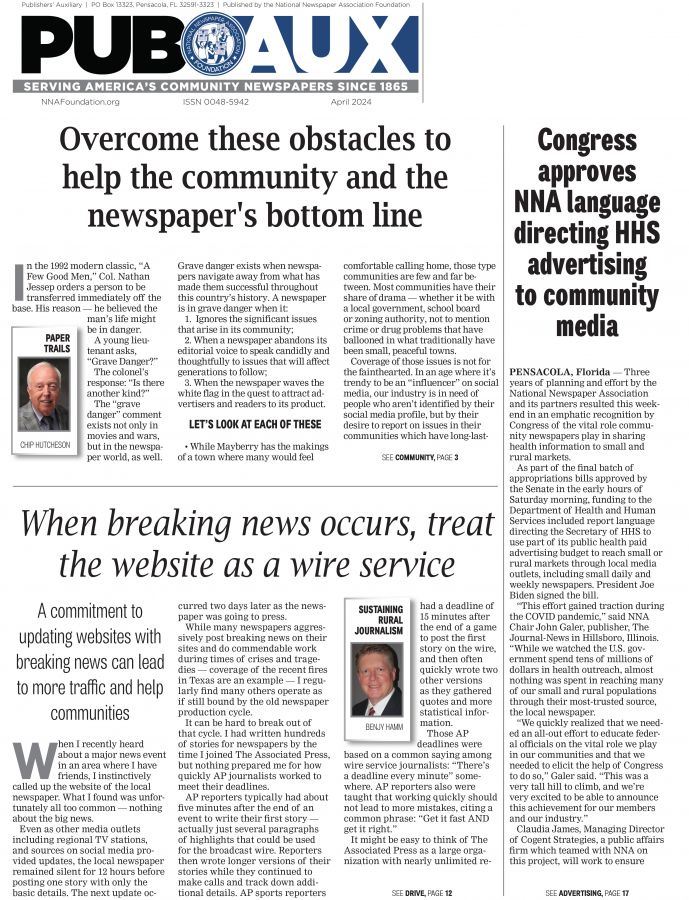PRC outlines future ‘skyrocketing’ postal costs
Tonda Rush
Mar 1, 2020

Imagine that you are spending $250 a week at your local post office, mailing some 2,000 newspapers to your readers. Service is pretty good, so long as you do most of the work: sort the papers by the carrier’s path down the street, bring bundles directly to the post office all ready to go out, fill out your own “bill” in the form of a postage statement and make sure there is cash on hand in your account plus a little extra in case the acceptance clerk comes up with a different weight than you got.
Now hear what the Postal Regulatory Commission (PRC) has in mind.
In 2021, your bill goes up to about $270. Instead of $13,000 a year, you’re going to pay $14,040. In 2022, it goes up again to about $292, and the annual is $15,184. In 2023, it is $315 or $16,000 a year. And the cost keeps escalating, maybe even a percentage point or two more than this scenario. It could get up to $20,000 a year or more by the end of five years.
While all of that increase is bearing down on your company, the first-class stamp used to send out invoices goes to 60 cents, then 70 cents, maybe even as high as $1.25. And that does not count the Standard Mail (now Marketing Mail) you may use to send renewal statements to subscribers or Total Market Coverage publications to nonsubscribers. All of that could be rising 30-50% over the next five years, as well.
That is the scenario that National Newspaper Association and other organizations representing users of business mail are combatting at the PRC this winter. The Commission has rolled out a proposal for future postage payments that removes the annual inflation-based cap on postage increases. Instead, it wants to give USPS the ability to increase postage to cover the looming costs it foresees. That includes fewer mail pieces going to each household, while the number of households needing mail delivery continues to expand. The costs also include losses of more than $70 billion on the USPS balance sheet because it has not been able to cover a $5 billion annual obligation to prefund the cost of future retirees’ health care. The proposal also covers a gap that the U.S. Postal Service says presently exists between newspaper postage and the actual cost of delivery newspapers, which USPS says amounts to about 35% more than publishers pay.
On top of this proposal, USPS has arrived at the Commission with its own ideas. It wants the PRC to grant it $6 billion in new postage revenue from rate increases before the schedule of annual percentage increases takes hold. If the PRC granted that request and assigned that responsibility for covering the cost to the first-class stamp, a repeat of last year’s 5-cent increase and more could be in store. The stamp could rise to well more than a dollar.
All of these possibilities arise as part of the PRC’s review of the 10-year-long cap on postage increases earned by NNA and others as part of Postal Accountability and Enhancement Act of 2006 (PAEA). The PRC is mandated to determine whether the price cap is sufficient to sustain USPS over the long haul. PRC already determined in 2017 that the cap has not produced enough revenue to keep universal service intact. Now, it is deliberating over what comes next.
“NNA has been greatly alarmed by the prospect that the PRC intends to let postage expenses skyrocket,” NNA President Matthew Adelman, publisher of the Douglas (Wyoming) Budget, said. “We have agreed in the past to reasonable increases in a balanced piece of legislation that helps USPS do a better job of controlling its costs. But Congress has not produced that legislation, and now the PRC seems determined to leap ahead with increases of its own. What is has in mind is wildly out of today’s realities in the printing and publishing industries.”
The formal proposal asked for comments from industry and consumers on whether substantial increases made sense. For newspapers, thought to be failing to cover costs, the proposal would allow USPS to pass along increases as follows:
• The annual inflation rate, presently around 2%.
• Two percent additional “supplemental authority” to help USPS cope with a decline in the density of mail delivered to each household and to cover a Congressional mandate to prepay its Retiree Health Benefits (RHB);
• An additional 1% if USPS met certain efficiency targets and also did not lower service standards (not actual service performance);
• Two percent more for mail like Periodicals that do not cover mail processing and delivery costs;
• Changes in workshare discounts, such as presorting of mail, or specific types of charges, such as the costs of bundles and containers, where the Commission has questioned whether the charges sufficiently compensate USPS.
When all the possibilities are added together and compounded over a proposed five–year schedule, the increases for a newspaper Periodical mailer could approach 50%. Similar increases would be applied to all other mail classes, such as the first-class stamp or postage-metered mail.
NNA provided comments to the PRC in February, vigorously protesting the proposed new rates. It laid out for the Commission the various stresses upon local newspapers, including the heightened cost of newsprint from 2018 trade sanctions, a shrinking retail base and competition from social media. It also attacked the assumption that Within County newspaper mail fails to cover costs, saying that USPS does little measurement of actual newspaper mail but instead relies upon data from the mailing of magazines to determine Periodical costs. Finally, it joined with other organizations such as the Greeting Card Association of America and the Envelope Manufacturers Association in a vision statement that called upon the PRC to halt its proceeding and instead issue a firm call to Congress to complete postal reform.
“NNA’s community newspapers cannot shoulder the burden that this Commission proposes. To the extent that they may have to bear more, they require better costing measurement on In County mail. But the bottom line is this: Congress must act, and until it does, any revenue enhancements that this Commission attempts to create will simply dig the USPS hole deeper,” Adelman said.
Adelman said the NNA Board of Directors had taken a firm stand against the increases and would take the case to Congress during the March Congressional Action Team Summit, March 25-27.
“We are pretty frustrated that Congress has not stepped up to the plate to complete postal reform. Now the PRC has decided that in light of Congress’s inaction, the Commission is going to impose the most intimidating set of new costs upon the industry that we have seen in decades. If Congress does not realize that the printing and publishing worlds can in no way absorb 50% increases in distribution costs in this environment, we are going to make sure that by the time NNA leaves town, the message has been delivered.”
The PRC does not have a declared schedule for issuing its decision. It will receive another set of comments in early March and then take a period of time to absorb the comments it has received. In order for the proposed new rates to take effect for 2021, its decision would need to be issued within the next 90 days, most industry observers have said. After the new rule is issued, USPS would still need time to analyze its needs, figure out which of the discretionary increases it wants to go for and do complex calculations on a new rate schedule. Typically, USPS tries to avoid major postage increases in the fall season, when mailing is at its heaviest.
A similar proposal was made by the PRC in 2017. After objections from the mailing industry, that proposal was stalled. The current iteration is intended to be based upon insights gained from the previous round of objections.
A new postal reform law from Congress could force the Commission to withdraw the proposal and retreat to a more modest schedule of increases.
Tonda Rush is the director of public policy and serves as general counsel to the National Newspaper Association. Email her at tonda@nna.org.









